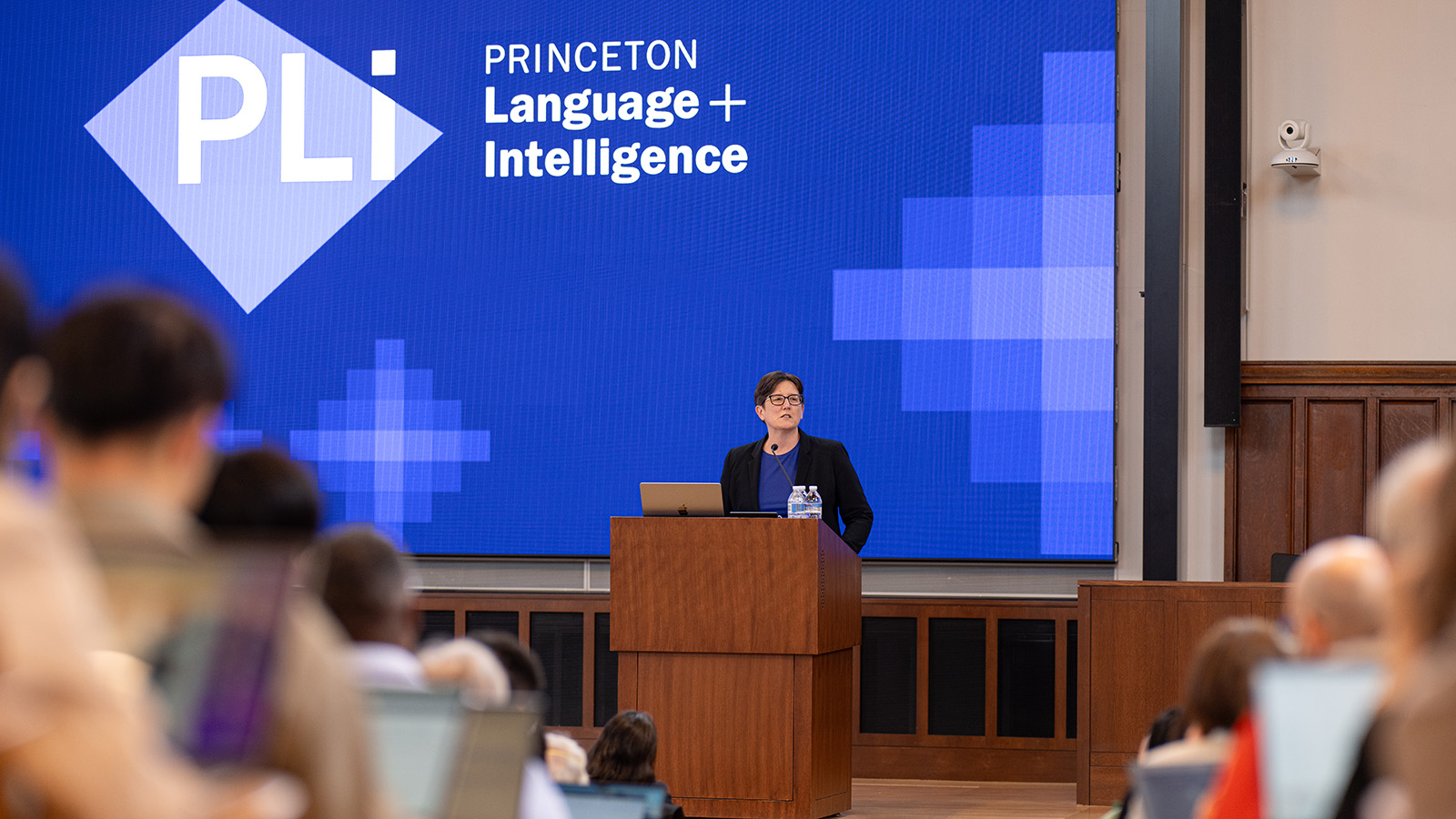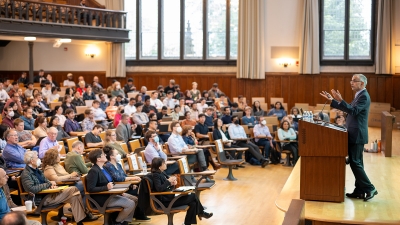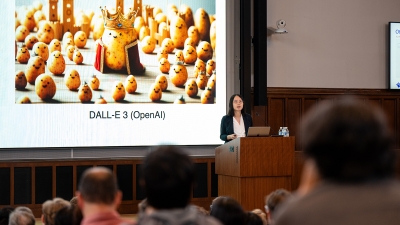By Liz Fuller-Wright, Office of Communications
ChatGPT took the public by storm a year ago, but Princeton experts have been working at the intersection of language and artificial intelligence for more than a decade.
“Over the past year or so, the pace of progress in artificial intelligence has surprised even the experts in the field, leading to exciting applications, unprecedented commercial investment — and understandable societal concerns,” said Princeton Provost Jennifer Rexford at the kickoff symposium for the Princeton Language and Intelligence (PLI) initiative on Sept. 26.

“The excitement about AI is palpable on this campus, most immediately evident in the large number of people attending today’s event,” Rexford said. “But it is also evident from our students, who flock en masse to AI-related courses, from introduction to machine learning to upper-level courses in computer vision, natural language processing, robotics and ethics.”
Watch each of the event’s talks here.
Rexford, who also is the Gordon Y.S. Wu Professor in Engineering, highlighted three core strengths of Princeton — fundamental research, interdisciplinary collaboration, and a commitment to public service — as driving a “virtuous cycle, where advances in AI methods enable more sophisticated applications, expanding the societal implications, and then feeding back to create AI methods that are more worthy of society’s trust.”
She noted that many Princeton researchers are already applying AI to societal challenges, including ethics, fairness, privacy and public policy, in the spirit of Princeton’s informal motto: “in the nation’s service and the service of humanity.”

Sanjeev Arora, Princeton’s Charles C. Fitzmorris Professor in Computer Science, who has conducted research at the intersection of language and AI for many years, will be the PLI director. “Given the rapid pace of progress within past years, it seems to me that artificial intelligence will be among the greatest inventions in history,” he said. “We should expect big societal changes. Workers are going on strike because of threats to their jobs from AI. Universities can help society and government understand and manage AI.”
Speed matters
Systems like ChatGPT and GPT-4 are known formally as large language models: AI systems that have been “fed” trillions of words — anything on the internet is fair game — to develop their skills in predicting the most likely next word and assembling grammatical sentences and paragraphs. The programs are “trained” by humans who assess the resulting text and provide feedback, and then the massive computers repeat this billions or trillions more times until they can consistently generate human-like text.
“You might have heard that a large language model is a neural net or a deep net, which makes you imagine that it is a physical device,” Arora explained. “It’s actually just a piece of code, computer code, running on a fast processor.”
And the faster the computer is, the better the model can be. To ensure that Princeton researchers can keep pace with the rapidly developing field, the University endowment is enabling the purchase of a state-of-the-art computer cluster and also funding human intelligence, in the form of a group of postdoctoral research fellows and research scientists and engineers at all levels.
“As they say on NPR, ‘Let’s do the numbers,’” said Arora. “$1 billion: The rumored cost of the computational hardware needed for a single large language model. Zero: The number of experts outside a company who know anything about it. No details are being released, so no outside experts can say with any confidence what a model will or will not do in any particular situation. $2 million to $3 million: The cost of the best computational hardware at any academic research group right now.”
And then Arora delivered the big news: “Starting in a couple of months, thanks to Provost Rexford and the University administration, Princeton will have a $10-million cluster, which will be the biggest in academia.”

“There’s so much we can do at this point,” said Danqi Chen, assistant professor of computer science and associate director of PLI. “I’m really looking forward to seeing our future efforts democratizing large language models in our academic ecosystem.”
She and the other associate director, Karthik Narasimhan, both spoke about “alignment,” the goal of aligning large language models with human values by providing human feedback. “Researchers find that if you only train large models to predict the next word, they often produce undesired or even toxic outputs,” Chen said. She described the Three H Principles of alignment: Helpful, honest and harmless. “We want the models to solve a task for us, to give us accurate information and even express uncertainty when they don’t know the answer,” she said. “We don’t want these models to cause any harm to people or the environment.”
AI across the curriculum
The Princeton Language and Intelligence initiative is led by a seven-person executive committee and a 10-person research advisory committee. Between the two, the institute’s leadership includes faculty from more than a dozen disciplines from every part of the University.
“Princeton researchers collaborate across disciplinary boundaries to apply AI to accelerate discovery in disciplines all over campus,” Rexford said. “We benefit from our small and intimate campus, the high quality across so many fields, and our patience for excellent research that has real impact.”
Researchers from every corner of campus have monitored AI developments, contributed to them, and applied AI tools to their own research.
Olga Troyanskaya, a professor of computer science and the Lewis-Sigler Institute for Integrative Genomics, is leading the Princeton Precision Health initiative, using AI to translate big data into better and more equitable clinical outcomes. She explained how large language models can be applied to the human genome because DNA is like a language written in only four letters — A, T, G and C — and with no punctuation.
“The human genome is 3 billion letters long, and we need to figure out what each of these letters means and what is the effect of any mutation,” she said. So far, scientists have identified most of the genes, but genes make up less than 2% of the genome.
“The rest is actually the instructions on when to turn those genes on and off and which version of the gene template to use,” she explained. “So, we’re not looking at genes, we’re looking at the other 98% with these AI models.”
A trained model will be able to recognize mutations — an A where a C should be, for instance, which prevents a gene from being turned on at a critical moment — and when combined with health data, the models can learn to predict which mutations are linked to which dangerous outcomes.
Princeton Precision Health is focusing on four fields of health: kidney disease and diabetes, the immune system and inflammation, neuropsychiatric disorders, and technology and mental health. The group includes computer scientists, clinicians, psychologists, sociologists, biologists, engineers and ethicists. “Ethics is a critical part of this initiative,” Troyanskaya said.

At the other end of the University’s academic spectrum, classics department chair Barbara Graziosi described using large language models to analyze texts from Homer, Aristotle and other ancient writers.
“We have about 1,000 witnesses, manuscripts and papyri for Homer, and not a single one is identical to any other,” said Graziosi, Princeton’s Ewing Professor of Greek Language and Literature. “Not a single one. Because they’re all handwritten. Accurate, but there are small differences. So how do we deal with these differences? That is the question here.”
As artificial intelligence, machine learning and large language models become integral to every sector of research and society, university experts will play ever more important roles, whether in keeping some models open-source and freely available or in monitoring the private models, said Rexford.
“AI is in danger of developing primarily inside private labs, with little opportunity for the rest of the world to know how it works or be assured that it is responsibly deployed with full safeguards,” said Rexford. “We are committed to keeping AI expertise and know-how in the public sphere. We are eager to work with institutional partners and companies who share our commitment to open research. Initiatives such as PLI can democratize AI knowledge, enhance transparency and accountability, and help ensure that benefits of AI accrue to all of humanity.”